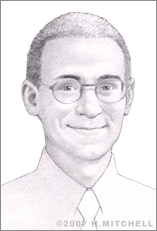Brian Schulkin
Terahertz radiation, which consists of electromagnetic waves sent at Terahertz (trillion cycles-per-second) frequencies, is among today’s most often-touted breakthrough technologies for sensing and imaging. It can “see” through a variety of nonconducting materials such as plastics, paper, wood, ceramics and skin, similar to x-rays. However, unlike x-rays, t-rays are non-ionizing, which means they may be safer for humans than x-rays are for some applications.
As a result, scientists around the world are working to find ways to harness the power of Thz technology and put it into widespread use. Applications are possible in fields from medical imaging and diagnosis to national security and industrial testing. A major challenge thus far, however, has been in developing pieces of equipment that are usable outside the lab.
Brian Schulkin was a doctoral student in physics at Rensselaer Polytechnic Institute (RPI) in Troy, New York when he brought the world one step closer to realizing the mainstream potential of Thz technology with his invention of the “Mini-Z,” a portable, ultra-light terahertz spectrometer.
Schulkin’s system, at less than five pounds and compact enough to fit inside a briefcase, is smaller than any similar, previous device; other existing tools are typically heavy and bulky, thus not portable, and require high-powered lasers, which makes them expensive.
Schulkin combined his expertise in Thz technology with his knowledge of optics and materials science to create a portable, laptop-sized device that is able to provide real-time data and allows for easy operation by people with little or no specialized training.
While working as a research staff member at NJIT, Oakland, N.J., native Schulkin helped develop a terahertz frequency range capable of imaging an object one kilometer away. Schulkin also worked to create specialized silicon crystals that can be used as a filter for the terahertz frequency range. The National Aeronautics and Space Administration (NASA) became interested in the crystals’ potential use for communication between satellites in 2002 and named Schulkin a NASA Space Grant Consortium Fellow, which gave him funding to develop a terahertz imaging technology for satellite communication.
He was admitted to RPI in 2004, where he earned an Integrated Graduate Education and Research Traineeship (IGERT) through the National Science Foundation. Associated funding allowed him to work under world-renowned T-ray expert and Rensselaer professor Xi-Cheng Zhang, and provided him with the resources that he needed to develop the Mini-Z, which he created in just a few months.
With colleagues, Schulkin was able to test the Mini-Z on space shuttle foam samples provided by NASA’s Marshall Space Flight Center and Lockheed Martin. His device was successful in detecting deliberately placed defects within the foam. Subsequently NASA’s External Tank Project Office has considered the Mini-Z as a possible tool for nondestructive evaluation of its vessels and materials.
The Mini-Z also has the potential to help physicians’ image tumors, to assist authorities in finding hidden biological agents at security checkpoints, and to help soldiers detect explosives and landmines. He hopes to be able to build a handheld version of a Thz device next.
For his efforts involving the Mini-Z and Thz technology research, Schulkin was awarded the first-ever $30,000 Lemelson-Rensselaer Student Prize in Feb. 2007. Earlier that year, he was named IMRA Fellow at The International Society of Optical Engineering’s yearly conference, Photonics West.


